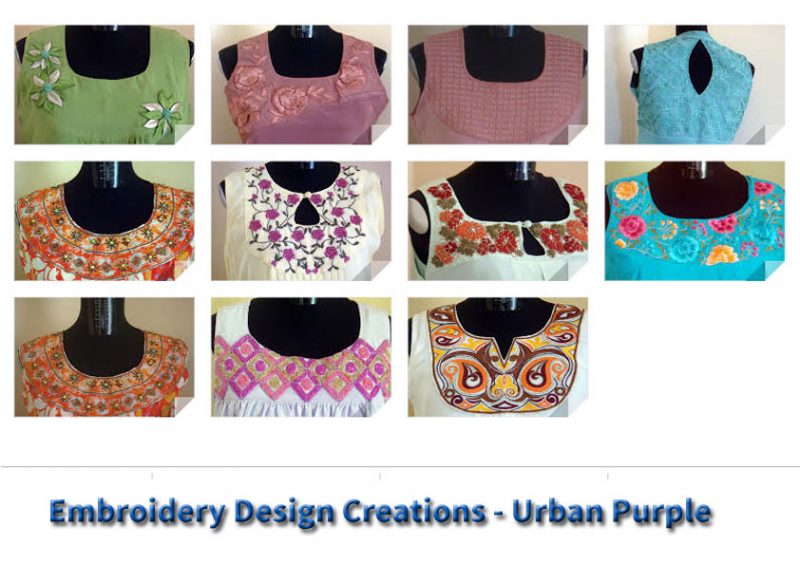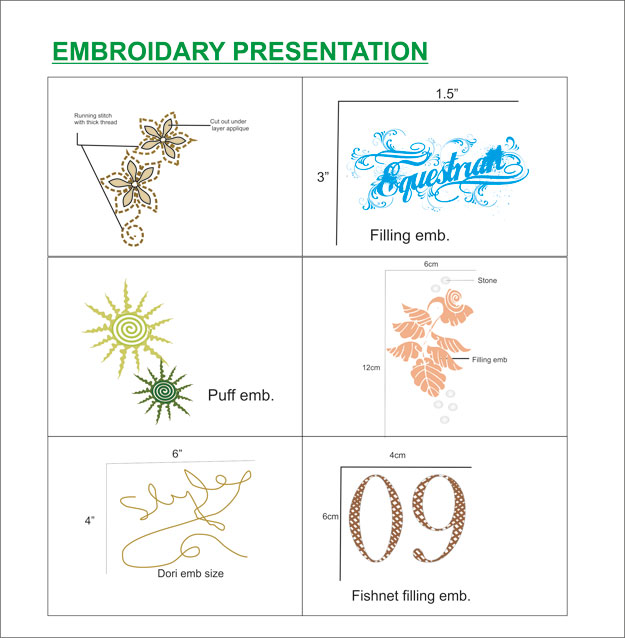Embroidery design is an integral part of the collection of premium luxury brands. Without it, the collection is not complete. Embroidery design plays a significant role in elevating the aesthetic appeal of garments. This is particularly true for luxury brands. Incorporating embroidery into clothing designs adds a touch of sophistication and exclusivity. This article will delve deep into modern embroidery techniques and processes. And try to understand the importance and execution process of fashion tech packs.
Evolution of Embroidery Design
Embroidery, dating back centuries, has evolved into a refined art form. Yet, the essence remains the same: adorning garments with intricate threadwork, beads, pearls, and zari work. The invention of the industrial embroidery machine in the 19th century revolutionized the production process. This enabled clothing manufacturers to meet the growing demand for apparel with embroidery. Converting apparel graphics into an embroidery piece efficiently is the specialty of automated machine embroidery. The luxury before was now available to the masses and affordable.
Importance of Embroidery in Fashion
Luxury fashion brands utilize embroidery to enhance the visual appeal of their collections. Garments featuring embroidery often command higher prices than their printed counterparts. This is due to the craftsmanship involved in clothing embroidery design and threadwork. This is organic and more appealing than prints. The cost of embroidery depends on factors such as the complexity of the design and the number of stitches required.
Embroidery Digitization Process
Embroidery digitization is a crucial step in transforming artwork into a format machine format. This process involves converting vector artwork into a digital embroidery file (DST format). This can be achieved using specialized CAD software. The embroidery file’s clarity and precision depend on the vector artwork’s quality. So, if the vector artwork in the tech packs is clear and high quality, it shows in embroidery. Here’s a detailed elaboration on each stage of the embroidery digitization process.
We can convert artwork to computerized embroidery format through embroidery digitization. Through this, we can convert artwork to a format to feed into the machine for embroidery. We can achieve this using various CAD software. Once the digitization process is complete, the DST file goes to the embroidery machine. There are separate embroidery designers who prepare the CAD file for embroidery. The clothing tech pack designer must give clear vector artwork to the embroidery designer. The clarity of the embroidery file depends on the clarity of the vector. So, the tech pack designer must provide clear CAD artwork in the tech pack with proper measurements. If you want more articles related to clothing design and tech packs, visit our blog, “Clothing tech pack design.”
-
Artwork Preparation
The process begins with the preparation of the artwork. The artwork is prepared based on the vector in the tech pack and will be embroidered onto the garment. It can be a logo, a design, or any other graphic element the client wishes to have embroidered. The artwork must be clean, clear, and in a vector format. This ensures the highest quality output in the embroidery process.
-
Digitization Software Selection
With the artwork, the designer uses specialized CAD software to digitize the artwork. Various embroidery digitization software is available, each with its features. The designer selects the appropriate software based on the machine and artwork complexity. The process depends on the artwork’s complexity and familiarity with the tool. The digitizer selects the appropriate software based on the complexity of the artwork.
- Digitization Process
The digitization process involves converting the artwork into a series of commands. The instructions that the embroidery machine can understand. The designer assigns stitch types, length, density, and direction to different areas of artwork. The digitizer traces the contours of the artwork, determining the stitch placement. This is done to get an accurate assessment to replicate the design based on the artwork.
-
Stitch Types and Parameters
The digitizer selects the appropriate stitch types and parameters based on the design. There are different types of stitches types available in machine embroidery. Those are stain stitches, fill stitches, and running stitches, which are the common stitches. Those stitch types are used interchangeably to create various textures and effects. The digitizer also adjusts parameters like stitch density, underlay stitch, and direction. Those are used to achieve the desired look and texture.
-
Testing and Refinement
Upon completion of the digitization process, the digitized design is tested in real-time using the embroidery machine. This allows the digitizer to understand the gaps and areas needing adjustments. Fine-tuning is necessary to ensure that the embroidered design matches the artwork.
-
File Output
After refinements, the final output of the digitized design is saved in a proper DST file format. This format contains the instructions for the embroidery machine to replicate the design. The digitized file is then ready to be loaded onto the embroidery machine for production.
Overall, the embroidery digitization process requires artistic skill and technical expertise. Attention to detail is vital for getting a precise result. This specialized skill plays a critical role in the production of embroidered garments. You need this skill to ensure the designs are translated accurately from the artwork.
Embroidery Design Integration into Garment Technical Specifications
The tech packs should clearly instruct the digitizer. This includes detailed vector artwork with measurements, color, and thread type. This helps understand the design and ensures an accurate reproduction of the design. Integrating embroidery into garment technical specifications involves documenting all necessary details, including the embroidery technique, thread types, and color. Here is how this process can be elaborated.
-
Embroidery Design Details
The tech pack should include detailed information about the embroidery design itself, including dimensions, design, artwork placement on the garment thread type, and color. It must also include all the above instructions and visually represent how the embroidery should look on the garment.
-
Thread and Color Specifications
The embroidery design is all about the thread. So, in the tech pack, specify the thread type and thread color to be used in the embroidery. Also, include the brand, color, and thread weight, if applicable. This ensures consistency in color and texture across different production batches. Additionally, provide the color code (Pantone Code) accurately in the tech pack.
-
Stitching Techniques and Density
Describe the stitching techniques to be employed in the embroidery. Embroidery stitches have many types, such as satin stitches, fill stitches, or appliqué. So, to achieve the desired result, the tech pack should mention the stitch length, density, and direction. This will help achieve the desired texture and effect on the artwork and embroidery. Include special instructions for areas of high detail or intricacy in the design.
-
Placement and Sizing
The placement of the embroidery in the garment is essential. The suitable artwork at the right place of the garment enhances the look and appeal of the garment. So, placement and measurements are crucial reference points the tech pack should include—for example, Neckline, hemline, sleeve seam, etc. The garment specification designer must provide the guidelines for cantering and aligning the embroidery. This should also be included with the other design elements on the garment. Also, it is essential to specify the scale of the embroidery according to the garment size gradation.
-
Sequencing and Layering
If the color or layer is multilayered, outline the sequence in which it should be stitched. If applicable, provide instructions for layering techniques such as applique or 3D. Securing or finishing the edges of the embroidery is essential to prevent unraveling or fraying.
-
Testing and Approval
It is necessary to keep a periodic record of versions of embroidery designs. So, it is a good practice to document the versions with requirements for testing and approval. Embroidery sample versions should be reviewed and finalized before the apparel production starts. Also, it is essential to specify the criteria for evaluating the quality and accuracy. Those parameters are stitch tension, thread tension, and overall appearance. Also include provisions to make any necessary adjustments to the embroidery design. That adjustment should be made based on the feedback received from the sample.
-
File Formats and Transfer
The file formats used in embroidery units are usually DST, EXP, or EMB files. However, there may be exceptions for some machines. So, it is necessary to specify the file formats and transfer methods for delivering to the embroidery units.
Embroidery details in the tech pack enhance understanding between designers and factories. So, by adding it with technical specifications, designers and manufacturers can ensure clear communication. This alignment throughout the production process makes it smooth and faster. This comprehensive approach helps minimize errors and streamline production workflow. The Buyer achieves the desired quality and consistency in embroidered garments. Embroidery design added a luxurious touch to garments. It is the first choice of premium brands for its ability to elevate the aesthetic appeal of the collection. So, understanding and implementing the embroidery digitization process into tech packs is critical. These are essential steps in producing high-quality embroidered garments. With the right expertise and resources, brands can leverage it to create an exclusive apparel collection.
Urban Purple is a group of technical fashion designers and consultants. We also run a digital download store for fashion tech packs, graphics, and textile prints. To learn more about our offering and buy fashion tech packs, visit our tech pack template store. You can choose your collection tech packs from a wide range of fashion tech packs. The tech packs are tested in factory environments. So, you can select your styles and buy from there. Download the apparel tech pack template with a detailed measurement spec sheet. You get the source vector file of the tech pack with the spec sheet in Excel format.


